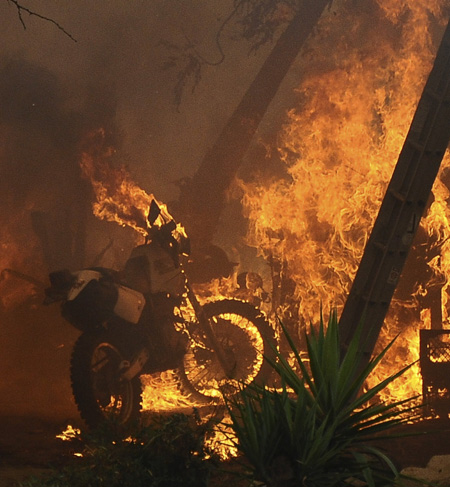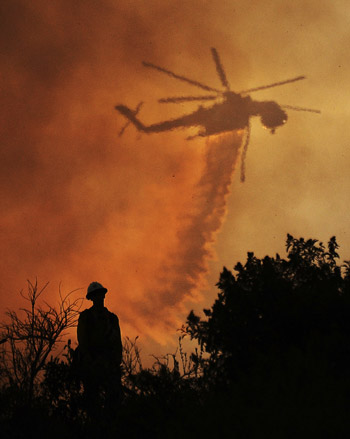Amid high temperatures, a wildfire was moving northwest in Los Angeles on Sunday after having burned more than 35,000 acres (about 14,175 hectares), authorities said.

|
|
A motorcycle burns during the Station Fire in the Big Tujunga area of Los Angeles, California August 29, 2009. [Xinhua/Reuters Photo]
|
About 2,000 firefighters were deployed to prevent the Station Fire from destroying more homes, the Los Angeles County Fire Department (LACFD) said.
The firefighters were assisted by water- and fire-retardant- dropping helicopters and fixed-wing aircraft, including a DC-10 jumbo jet, which can dump up to 12,000 gallons of fire retardant in eight seconds, according to the department.
The fire is about 5 percent contained, with full containment not expected until Sept. 8, said the department. How the fire started has not been established.
Three homes and about 30 cabins in the Angeles National Forest have been destroyed, with 10,000 other foothill homes and some 2, 000 commercial buildings threatened, firefighters said.
Three civilians have been hurt -- two in the Big Tujunga Canyon area and one off Highway 2 near Mount Wilson.

|
|
A firefighter watches a water drop at the Station Fire in Angeles National Forest above the La Canada Flintridge area of Los Angeles, California August 28,2009. [Xinhua/Reuters Photo]
|
With temperatures expected to reach the mid- to high 90s Fahreinheit on Sunday in the fire areas, officials said they were expecting extreme fire conditions, mirroring Saturday's, when flames leapt as high as 80 feet and spread at a rate of about 2.5 miles (four kilometers) an hour.
The fire is also threatening the Santa Clarita Valley, broadcast facilities on Mount Wilson and the Jet Propulsion Laboratory in La Canada Flintridge.
The Station Fire broke out Wednesday afternoon near a ranger station and the Angeles Crest Highway north of La Canada Flintridge and has prompted evacuation orders for as many as 4,000 homes.
A mushroom-shaped cloud of smoke and vapor that could be seen across the Los Angeles Basin rose to about 20,000 feet over the mountains Saturday, as the fire grew on all fronts, driven primarily by dry conditions and high heat.
The air quality in some cities in the Los Angeles area was deemed unhealthful by the regional air-quality agency.
Touring the command post Sunday morning, California Governor Arnold Schwarzenegger said the government was closely monitoring the developments and would try every means possible to contain the fire which was "very challenging."
The governor has declared an emergency in Los Angeles County.
LACFD Capt. Bill Sanchez said fire crews needed to cut about 110 miles (176 kilometers) of fire line to stop the fire's trajectory.
He said the wind changed direction overnight, particularly in the mountainous areas of the Angeles National Forest, to a down- canyon wind, which pushed it toward some residential areas.
"Due to the volatility at the top of some of the areas, it is going to be really challenging," Sanchez said. "We have a lot of work ahead of us. There is quite a bit of instability at the top of the fire."